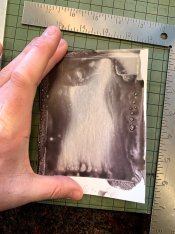grainyvision
Subscriber
So I'm using a weird coating method (see window coating thread) but keep encountering problems, despite overall coating thickness being fairly event. The specific problem is spots, I believe referred to as "repellency spots". Basically I coat the emulsion, but portions of the paper seem to repel the emulsion. This occurs across 3 different papers reported to work well for wet coating. The emulsion used was the silver chloride emulsion in The Handmade Silver Gelatin Print, but with sodium chloride substitution for the potassium chloride. Overall recipe:
A:
* 25g gelatin
* 150ml water
* 2.5g sodium chloride
B:
* 5g silver nitratre
* 25ml water
Finals:
* 10 drops of photo-flo 200
* 10ml ethanol (everclear)
Coating temp I've tried anywhere from 38 to 44C. All give issues
I'm using a prototype 3d printed emulsion well as well as puddle pusher with the thickness set to effectively 10 mils. A little thick for paper emulsion, but seems to work fine other than these spots. The papers used were
* Strathmore Bristol smooth surface 100lb
* Arches hot pressed 140lb
* Strathmore mixed media 400 series 184lb
I coated using standard wet coating as described by Denise. ie, soak paper for a few minutes, squeegee to remove excess water, put on "frame" determining thickness, fill emulsion well, coat paper with well/puddle pusher (sometimes tried holding the puddle pusher along with the well, and sometimes I quickly ran the well over the paper then followed with the puddle pusher after). Despite trying various methods, these spots persisted in all of them. Maybe too much water evaporated, or maybe too much water was in the emulsion? I tried adding a few more drops of photo-flo but that didn't seem to help. Weirdly, the first 2 or 3 sheets coated seemed to work fine without these spots and may have been coated at a higher temp (44C), but shortly after I kept getting this spotting problem no matter the temp used.
What steps should I take to try to troubleshoot this issue? I've attached some pictures of what the issue looks like on paper simply exposed to the sun to become dark. I also tried dry coating (results attached), but the emulsion migrated shortly after coating (ie, when it cupped up, the emulsion ran thin in the center). I don't see how dry coating like this can work, though the one good thing is no spots oddly enough. A dry process would definitely be preferable if it were possible to use with consistency.
A:
* 25g gelatin
* 150ml water
* 2.5g sodium chloride
B:
* 5g silver nitratre
* 25ml water
Finals:
* 10 drops of photo-flo 200
* 10ml ethanol (everclear)
Coating temp I've tried anywhere from 38 to 44C. All give issues
I'm using a prototype 3d printed emulsion well as well as puddle pusher with the thickness set to effectively 10 mils. A little thick for paper emulsion, but seems to work fine other than these spots. The papers used were
* Strathmore Bristol smooth surface 100lb
* Arches hot pressed 140lb
* Strathmore mixed media 400 series 184lb
I coated using standard wet coating as described by Denise. ie, soak paper for a few minutes, squeegee to remove excess water, put on "frame" determining thickness, fill emulsion well, coat paper with well/puddle pusher (sometimes tried holding the puddle pusher along with the well, and sometimes I quickly ran the well over the paper then followed with the puddle pusher after). Despite trying various methods, these spots persisted in all of them. Maybe too much water evaporated, or maybe too much water was in the emulsion? I tried adding a few more drops of photo-flo but that didn't seem to help. Weirdly, the first 2 or 3 sheets coated seemed to work fine without these spots and may have been coated at a higher temp (44C), but shortly after I kept getting this spotting problem no matter the temp used.
What steps should I take to try to troubleshoot this issue? I've attached some pictures of what the issue looks like on paper simply exposed to the sun to become dark. I also tried dry coating (results attached), but the emulsion migrated shortly after coating (ie, when it cupped up, the emulsion ran thin in the center). I don't see how dry coating like this can work, though the one good thing is no spots oddly enough. A dry process would definitely be preferable if it were possible to use with consistency.













